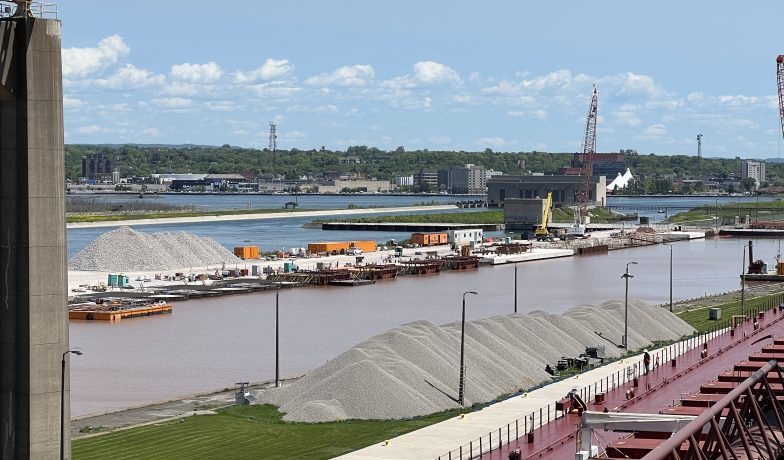Locked In
The need for a second Poe-sized lock at the Soo has been on the Great Lakes maritime industry’s agenda for nearly 40 years; and, in fact, a new maximum-size lock was authorized in 1986. It’s been a long time coming, but completion of the 1200’ x 110’ x 32’ new lock is now on the horizon.
The US Army Corps of Engineers (USACE) expects completion in 2030, but “with consistent funding and favorable weather, the new lock could be completed earlier than anticipated,” said Carrie D. Fox, USACE, Detroit District Public Affairs Specialist. This could be as soon as 2027.
In January 2022, the USACE announced that the newly-passed Infrastructure Investment and Jobs Act (IIJA) included some $479 million to fund completion of its New Soo Lock project.
This news was welcomed enthusiastically throughout the Great Lakes maritime industry. Having the funding represents security in the knowledge that a second Poe-sized lock will be available, particularly in the event of a problem with the existing Poe Lock. This enhances the reliability of the entire Great Lakes system and, as Lake Carriers’ Association pointed out, provides resiliency that is critical not only for Great Lakes cargo carriers, but also for their customers.
“The Soo Locks are national critical infrastructure, and their reliability is essential to U.S. manufacturing and national security.”
-Kevin McDaniels, USACE, Detroit District, Deputy District Engineer
“A failure of the Poe Lock would have significant impacts to the US economy, especially the steel industry. The new lock will provide much-needed resiliency.”
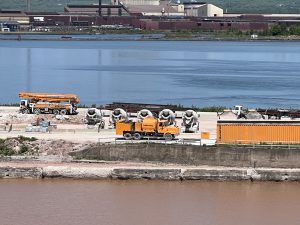
The IIJA funding particularly impacts the ability of the Corps to complete Phase III of construction, which includes actual construction of the new lock chamber. Total construction cost of the New Soo Lock now stands at about $1.3 billion.
Construction Timeline
Work on Phase I construction is currently wrapping up. And progress continues on Phase II.
Phase III construction is set to begin this season as soon as contractor selection is complete. A contract announcement is expected soon. “Phase III is currently in source selection,” Fox said, “and the [Federal] government cannot provide information that may threaten the integrity of completion.”
Phase I, dredging of the upstream approach channel to accommodate the largest Great Lakes vessels, included removal of 250,000 cubic yards of sandstone and overburden. The process began in spring 2020, continued in 2021, and resumed this spring. “Phase I is nearly completed, with approximately 3000 cubic yards of material remaining to be removed,” Fox reported in early May. “Phase I is scheduled to be complete this summer.” The Phase I contractor is Trade West Construction Co. of Nevada.
Phase II, now in its second season of work, includes rehabilitation of the upstream approach walls and deepening of the Federal channel in the downstream lock approach. The Phase II contractor, Kokosing–Alberici, LLC, is a joint venture of Kokosing Industrial of Ohio and Alberici Constructors of Missouri.
Work on the upstream approach walls began in 2021, during which the first 26 of 52 coffer cells were placed to rehabilitate the upstream approach walls. Following winter seasonal downtime, work began again this year in mid-April, and is on schedule for completion by fall 2023. Subcontractor L.B.Foster Company is supplying approximately 5,750 tons of steel piling to Kokosing-Alberici for the stabilization project.
Deepening of the downstream approach required drilling and blasting 77,000 cubic yards of material, mostly sandstone, which was then excavated and loaded into barges. The barges moved the material above the locks where it was unloaded and hauled to the designated disposal area.
Anticipated Completion
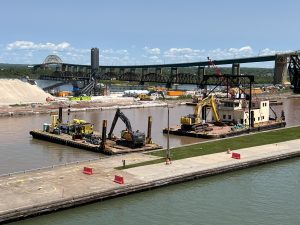
Phases I and II were largely funded prior to approval of the IIJA funding. “Phase III is the largest of the New Lock construction phases,” Fox explained. “Coffer cells will be built to dewater the construction site, power needs to be rerouted through the facility, the Sabin Lock chamber demolished, a new chamber constructed to the dimensions of 1200’ x 110’ (same size as the Poe Lock), the Davis Lock filled in, a new pump well installed, and the downstream approach walls rehabilitated. Phase III is anticipated to take eight years to complete.”
A major component of Phase III is the actual construction of the new lock chamber. Design of the chamber is complete, and will include hands-free mooring, which is in use throughout the rest of the Great Lakes/St. Lawrence Seaway system. In designing the new lock, the USACE used virtual reality, allowing crews to walk through the project virtually to help identify possible issues and challenges before the design was finalized. Building the new lock to the same dimensions as the Poe also means that many parts are interchangeable.
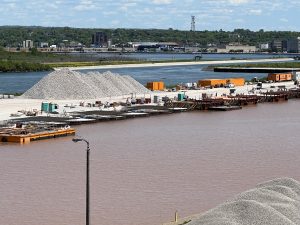
The construction project is not expected to affect commercial vessel traffic at the Soo. “There are no expected delays or effects to shipping traffic at the Soo Locks,” said Fox. “The Hydro Plant Tail Race will temporarily close to fishermen and recreational boaters while power is rerouted; [this is] expected to take place in the 2022-2023 construction seasons. Lock traffic continues to take precedence on the river, and construction activities related to lock construction will not be occurring in the South Channel where the two active locks are located.
“The New Lock at the Soo is a top priority for the Corps of Engineers and [we are] using resources across the country to deliver the project,” Fox continued. “The Corps recognizes the importance of delivering this vital piece of infrastructure for the nation.”
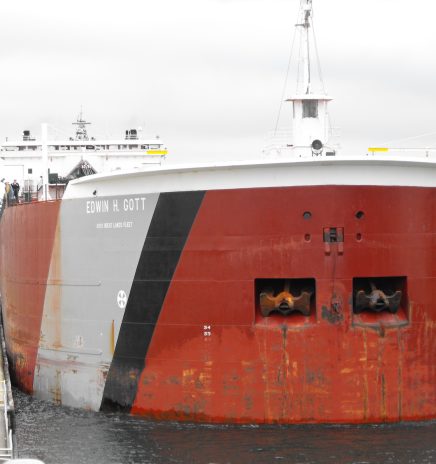
Legacy of the Soo: The Remarkable Story of the Lock that Almost Wasn’t
On June 29, 1984, then-U.S. Reps. Don Albosta (D-Michigan) and Bob Davis (R-Michigan) successfully offered a floor amendment in the U.S. House of Representatives, beginning the legislative process that would... Read More

Industry Stakeholders Gather for the AGLPA 2025 Conference
Photos by Victor Studio – Chicago, Illinois The annual American Great Lakes Ports Association (AGLPA) Conference took place August 14 and 15. Industry stakeholders and leaders met for the two-day... Read More

